Exercises Linked Comprehension from CENGAGE CHEMISTRY Chapter 11 IONIC EQUILIBRIUM for Class 11
| Class 11 | CHEMISTRY |
| Chapter | IONIC EQUILIBRIUM |
| CENGAGE CHEMISTRY | Exercises Linked Comprehension |
| Medium | English |
| Academic Year | 2023-2024 |
Question 4
Acid-base indicator such as methy1 orange, phenolphthalein, and bromothymol blue ate substances which change colour accroding to the hydrogen ion concentration of the solution to which they are added.
Most indicators are weak acids (or more rarely weak base) in which the undissociated and dissociated forms have different and distinct colours. If methy1 orange is used as the examples and the un-dissociated forms is written as HMO, then dissociation occurs as shown below:
Reaction: HMO⇔H⊕+MOΘRedColourlessYellow
The indicator should have a sharp colour change with the equivalence point of the titration. Usually the colour change of the indicator occurs over a range of about two pH units. It should be noted that the eye cannot detect the exact end point of the tiytration. The pKa of the indicator should be near the pH of the solution at the equivalance point.
Which of the following sitution exists at the equivalence point of titration? View SolutionQuestion 5
Acid-base indicator such as methy1 orange, phenolphthalein, and bromothymol blue ate substances which change colour accroding to the hydrogen ion concentration of the solution to which they are added.
Most indicators are weak acids (or more rarely weak base) in which the undissociated and dissociated forms have different and distinct colours. If methy1 orange is used as the examples and the un-dissociated forms is written as HMO, then dissociation occurs as shown below:
Reaction: HMO⇔H⊕+MOΘRedColourlessYellow
The indicator should have a sharp colour change with the equivalence point of the titration. Usually the colour change of the indicator occurs over a range of about two pH units. It should be noted that the eye cannot detect the exact end point of the tiytration. The pKa of the indicator should be near the pH of the solution at the equivalance point.
Given that the Ka (methy1 orange) =4.0×10−4, a solution at pH=2 containing the indicator would be View SolutionQuestion 6
Acidic solution is defined as a solution whose [H⊕]>[ΘOH]. Base solution has [ΘOH]>[H⊕]. During acid-base titrations, pH of the mixture will change depending on the amount base added. This variation is shown in the form of graph by making plot as titration curves 100mL of 1.0MH3A(Ka1=10−3,Ka2=10−5,Ka3=10−7) is titrated against 0.1MNaOh. The titration curve is as follows.

What is the pH at point A? View SolutionQuestion 7
Acidic solution is defined as a solution whose [H⊕]>[ΘOH]. Base solution has [ΘOH]>[H⊕]. During acid-base titrations, pH of the mixture will change depending on the amount base added. This variation is shown in the form of graph by making plot as titration curves 100mL of 1.0MH3A(Ka1=10−3,Ka2=10−5,Ka3=10−7) is titrated against 0.1MNaOh. The titration curve is as follows.

What would be the pH is more of NaH2A is added to the titration mixture at point C ?View SolutionQuestion 8
Acidic solution is defined as a solution whose [H⊕]>[ΘOH]. Base solution has [ΘOH]>[H⊕]. During acid-base titrations, pH of the mixture will change depending on the amount base added. This variation is shown in the form of graph by making plot as titration curves 100mL of 1.0MH3A(Ka1=10−3,Ka2=10−5,Ka3=10−7) is titrated against 0.1MNaOh. The titration curve is as follows.

What will be the change in pH from point B to point C?View SolutionQuestion 9
In equalitative analysis, cations of graph II as well as group IV both are precipitated in the form of sulphides. Due to low value of Ksp of group II sulphides, group reagent is H2S in the presence of dil. HC1, and due to high value of Ksp of group IV sulphides, group reagent is H2S in the presence of NH4OH and NH4C1. In a solution containing 0.1M each of Sn2+,Cd2+, and Ni2+ ions, H2Sgas is passed.
KspofSnS=8×10−29,KspofCdS=1510−28,KspofNiS−3×10−21,K1ofH2S=1×10−7,K2ofH2S=1×10−14
If H2S is passed into the above mixture in the presence of HC1, which ion will be precipitated first? View SolutionQuestion 10
In equalitative analysis, cations of graph II as well as group IV both are precipitated in the form of sulphides. Due to low value of Ksp of group II sulphides, group reagent is H2S in the presence of dil. HC1, and due to high value of Ksp of group IV sulphides, group reagent is H2S in the presence of NH4OH and NH4C1. In a solution containing 0.1M each of Sn2+,Cd2+, and Ni2+ ions, H2Sgas is passed.
KspofSnS=8×10−29,KspofCdS=1510−28,KspofNiS−3×10−21,K1ofH2S=1×10−7,K2ofH2S=1×10−14
At what value of pH,NiS will start to precipitate? View SolutionQuestion 11
In equalitative analysis, cations of graph II as well as group IV both are precipitated in the form of sulphides. Due to low value of Ksp of group II sulphides, group reagent is H2S in the presence of dil. HC1, and due to high value of Ksp of group IV sulphides, group reagent is H2S in the presence of NH4OH and NH4C1. In a solution containing 0.1M each of Sn2+,Cd2+, and Ni2+ ions, H2Sgas is passed.
KspofSnS=8×10−29,KspofCdS=1510−28,KspofNiS−3×10−21,K1ofH2S=1×10−7,K2ofH2S=1×10−14
Which of the following sulphides is more soluble in pure water? View SolutionQuestion 12
In equalitative analysis, cations of graph II as well as group IV both are precipitated in the form of sulphides. Due to low value of Ksp of group II sulphides, group reagent is H2S in the presence of dil. HC1, and due to high value of Ksp of group IV sulphides, group reagent is H2S in the presence of NH4OH and NH4C1. In a solution containing 0.1M each of Sn2+,Cd2+, and Ni2+ ions, H2Sgas is passed.
KspofSnS=8×10−29,KspofCdS=1510−28,KspofNiS−3×10−21,K1ofH2S=1×10−7,K2ofH2S=1×10−14
If 0.1MHC1 is mixed in the solution containing only 0.1MCd2+ ions and saturated with H2S, then [Cd2+] remaining in the solution after CdS stopes to precipitate is: View SolutionQuestion 13
The degree of dissociation of weak electrolyde is inversely proportional to the square root fo concentration. It is called Ostwald's dilution law.
α=√Kac As the tempertaure increases, degree of dissociation will increase.
α1α2=√Ka1Ka2 if concentration is same.
α1α2=√c2c1 if acid is same.
0.01MCH3COOH has 4.24% degree of dissociation, the degree of dissociation of 0.1MCH3COOH will be View SolutionQuestion 14
The degree of dissociation of weak electrolyde is inversely proportional to the square root fo concentration. It is called Ostwald's dilution law.
α=√Kac As the tempertaure increases, degree of dissociation will increase.
α1α2=√Ka1Ka2 if concentration is same.
α1α2=√c2c1 if acid is same.
pH of 0.005MHCOOH[Ka=2×10−4] is equal to View SolutionQuestion 15
The degree of dissociation of weak electrolyde is inversely proportional to the square root fo concentration. It is called Ostwald's dilution law.
α=√Kac As the tempertaure increases, degree of dissociation will increase.
α1α2=√Ka1Ka2 if concentration is same.
α1α2=√c2c1 if acid is same.
a1 and a2 are in ratio of 1:2,Ka1=2×10−4. What will be Ka2? View SolutionQuestion 22
Acid rain takes place dur to combination of acidic oxides with water and it is an envirronmental concern all over the world. Assuming rain water is uncontaminated with HNO3 or H2SO4 and is in equilibrium with 1.25×10−4atmCO2. The Henry's law constant (KH) is 1.25×106torr.Ka1 of H2CO3=4.3×10−7
Given : KfCuCIΘ=1.0(Kf is formation constant of CuCI⊕)
What is the pH of neturak rain water ? View SolutionQuestion 23
Acid rain takes place dur to combination of acidic oxides with water and it is an envirronmental concern all over the world. Assuming rain water is uncontaminated with HNO3 or H2SO4 and is in equilibrium with 1.25×10−4 atm CO2. The Henry's law constant (KH) is 1.25×106torr.Ka1 of H2CO3=4.3×10−7
Given : KfCuCIΘ=1.0(Kf is formation constant of CuCI⊕)
If SO2 content is the atomsphere is 0.64ppm by volume, pH of rain water is (assume 100% ionisation of acid rain as monobasic acid). View SolutionQuestion 24
In atmosphere, SO2 and NO are oxidised to SO3 and NO2, respectively,w hcih react with water to given H2SO4 and HNO3. The resultant solution is called acid rain. SO2dissolves in water to form diprotic acid.
SO2(g)+H2O(l)⇔HSOΘ3+H⊕,Ka1=10−2.
HSOΘ3⇔SO2−3+H⊕,Ka2=10−7
and for equilibrium,
SO2(aq)+H2O(l)⇔SO2−3(aq)+2H⊕(aq)
Ka=Ka1×Ka2=10−9at300K.
Which of the following reagnets will given white precipitate with the aqueous solution of sulphurous acid? View SolutionQuestion 25
In atmosphere, SO2 and NO are oxidised to SO3 and NO2, respectively,w hcih react with water to given H2SO4 and HNO3. The resultant solution is called acid rain. SO2dissolves in water to form diprotic acid.
SO2(g)+H2O(l)⇔HSOΘ3+H⊕,Ka1=10−2.
HSOΘ3⇔SO2−3+H⊕,Ka2=10−7
and for equilibrium,
SO2(aq)+H2O(l)⇔SO2−3(aq)+2H⊕(aq)
Ka=Ka1×Ka2=10−9at300K.
The pH of 0.01M aqueous solutioon of sodium sulphite (Na2SO3)View SolutionQuestion 26
In atmosphere, SO2 and NO are oxidised to SO3 and NO2, respectively,w hcih react with water to given H2SO4 and HNO3. The resultant solution is called acid rain. SO2dissolves in water to form diprotic acid.
SO2(g)+H2O(l)⇔HSOΘ3+H⊕,Ka1=10−2.
HSOΘ3⇔SO2−3+H⊕,Ka2=10−7
and for equilibrium,
SO2(aq)+H2O(l)⇔SO2−3(aq)+2H⊕(aq)
Ka=Ka1×Ka2=10−9at300K.
The dominant equilibrium in an aqueous solution of sodium hydrogen sulphite (NaHSO3) is
2HSOΘ3(aq)⇔SO2(aq)+SO2−3(aq)+H2O(l)
The equilibrium constant for the above reaction is View SolutionQuestion 27
In atmosphere, SO2 and NO are oxidised to SO3 and NO2, respectively,w hcih react with water to given H2SO4 and HNO3. The resultant solution is called acid rain. SO2dissolves in water to form diprotic acid.
SO2(g)+H2O(l)⇔HSOΘ3+H⊕,Ka1=10−2.
HSOΘ3⇔SO2−3+H⊕,Ka2=10−7
and for equilibrium,
SO2(aq)+H2O(l)⇔SO2−3(aq)+2H⊕(aq)
Ka=Ka1×Ka2=10−9at300K.
Which of the following statement is correct? View SolutionQuestion 28
In acid-base titration react rapidly to neutralise each other. Equivalence point is a point at which the acid and the base (or oxidising agent and reducing agent) have beem added in equivalent quantities. The end point in the point at which the titration stops. since the purpose of the indicator is to stop the titration close to the point at which the acid and base were added in equivalent quantities, it is important that the equivalent point and the end point be as close as must change colour at a pH close to that of a solution of the salt of the acid base. Singificantly, the pH changes most rapidly near the equivalent point. The exact shape of a titration curve depends on Ka and Kb of acid and base.
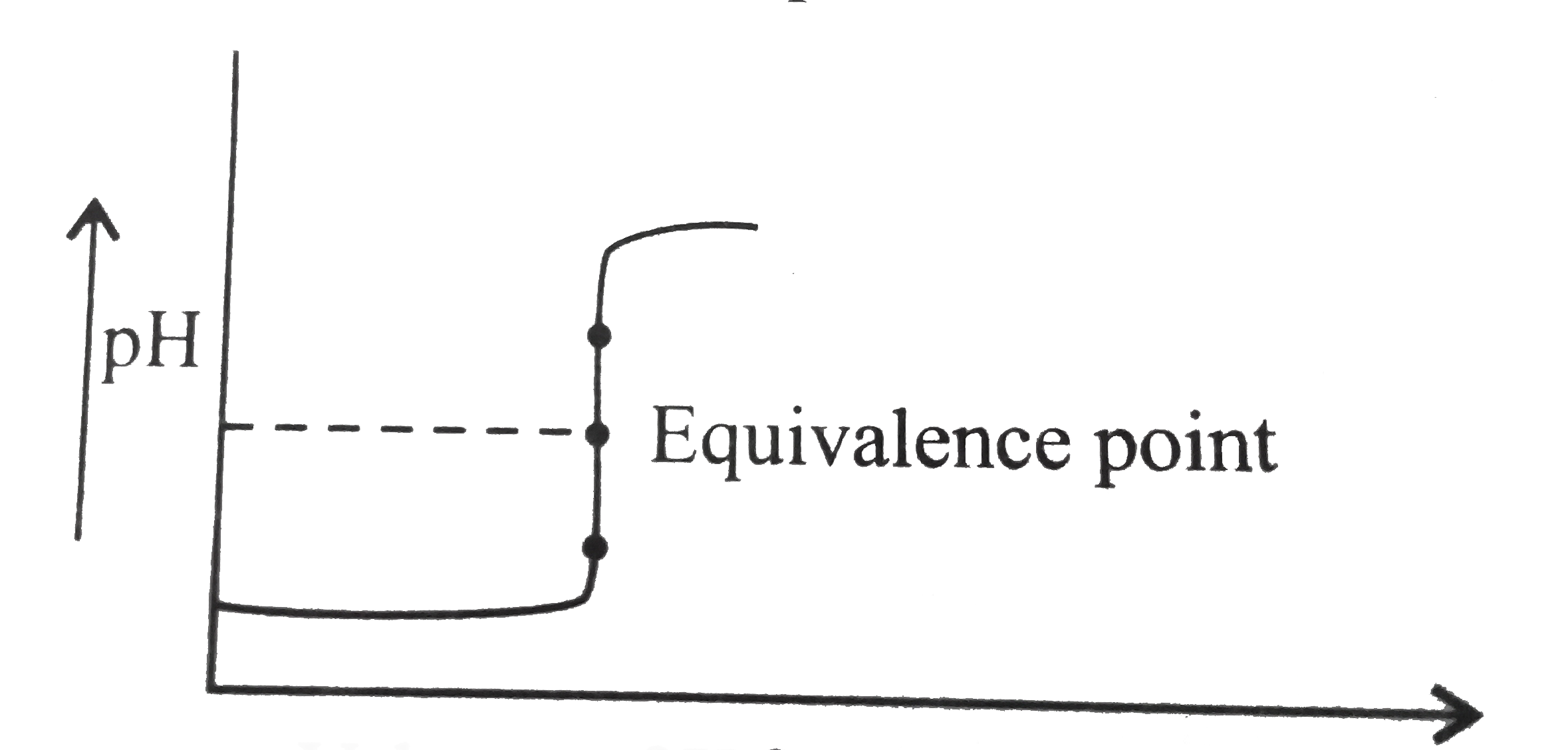
The following curve represents titration curve of HCI against KOH. The pH at equivalent point is
Examine the titration curve below and answer the question.
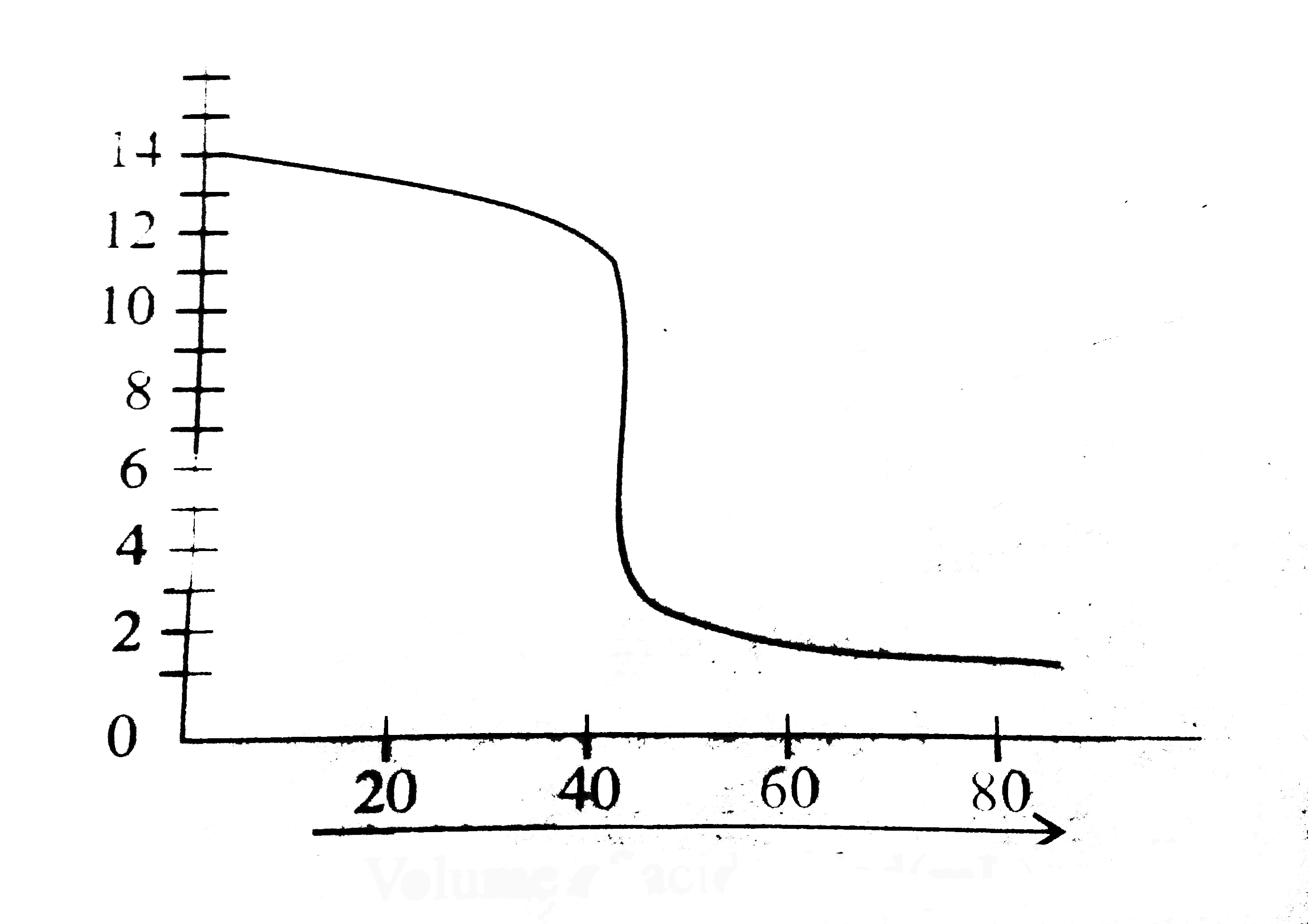 View Solution
View SolutionQuestion 29
In acid-base titration react rapidly to neutralise each other. Equivalence point is a point at which the acid and the base (or oxidising agent and reducing agent) have beem added in equivalent quantities. The end point in the point at which the titration stops. since the purpose of the indicator is to stop the titration close to the point at which the acid and base were added in equivalent quantities, it is important that the equivalent point and the end point be as close as must change colour at a pH close to that of a solution of the salt of the acid base. Singificantly, the pH changes most rapidly near the equivalent point. The exact shape of a titration curve depends on Ka and Kb of acid and base.
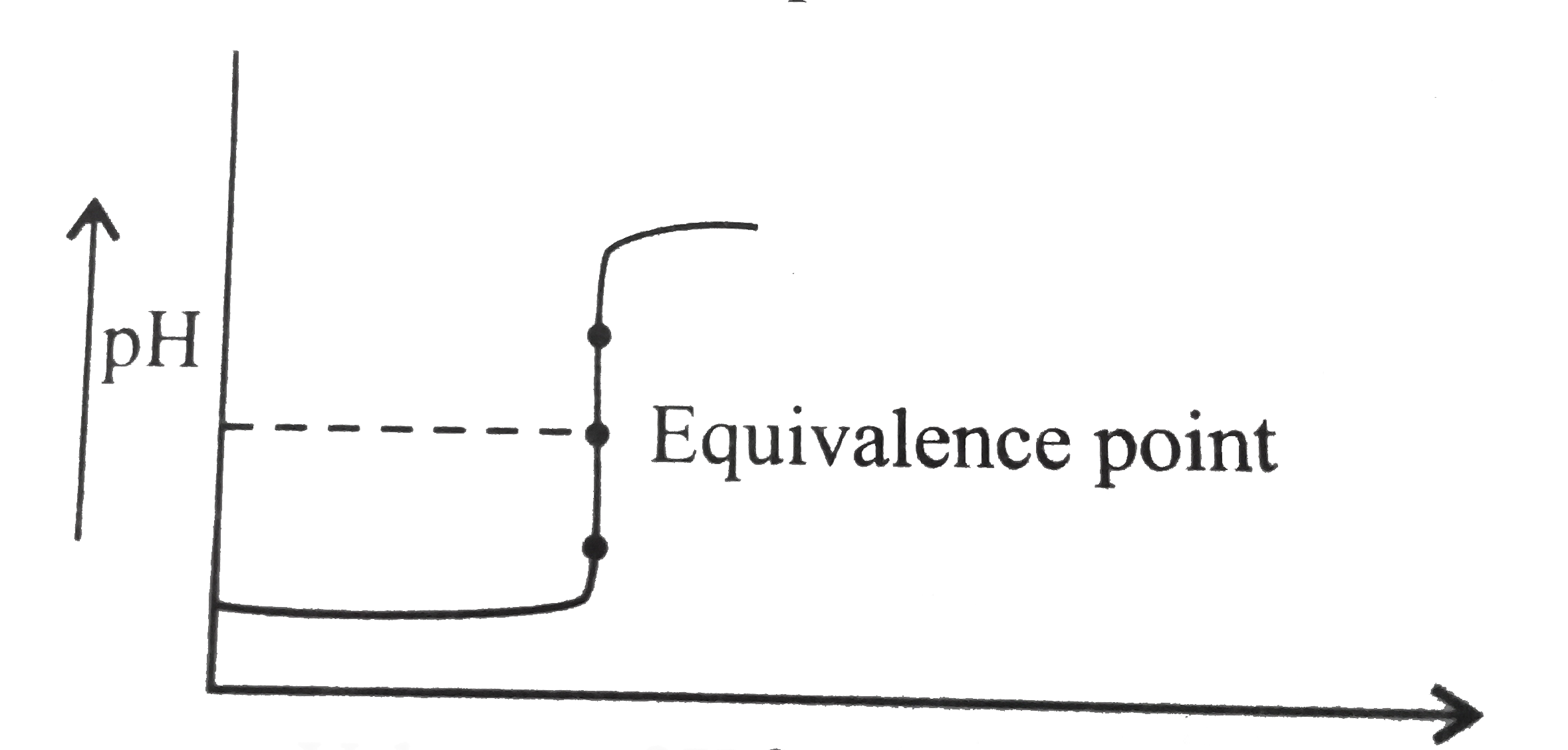
The curve represents the titration of View SolutionQuestion 30
In acid-base titration react rapidly to neutralise each other. Equivalence point is a point at which the acid and the base (or oxidising agent and reducing agent) have beem added in equivalent quantities. The end point in the point at which the titration stops. since the purpose of the indicator is to stop the titration close to the point at which the acid and base were added in equivalent quantities, it is important that the equivalent point and the end point be as close as must change colour at a pH close to that of a solution of the salt of the acid base. Singificantly, the pH changes most rapidly near the equivalent point. The exact shape of a titration curve depends on Ka and Kb of acid and base.
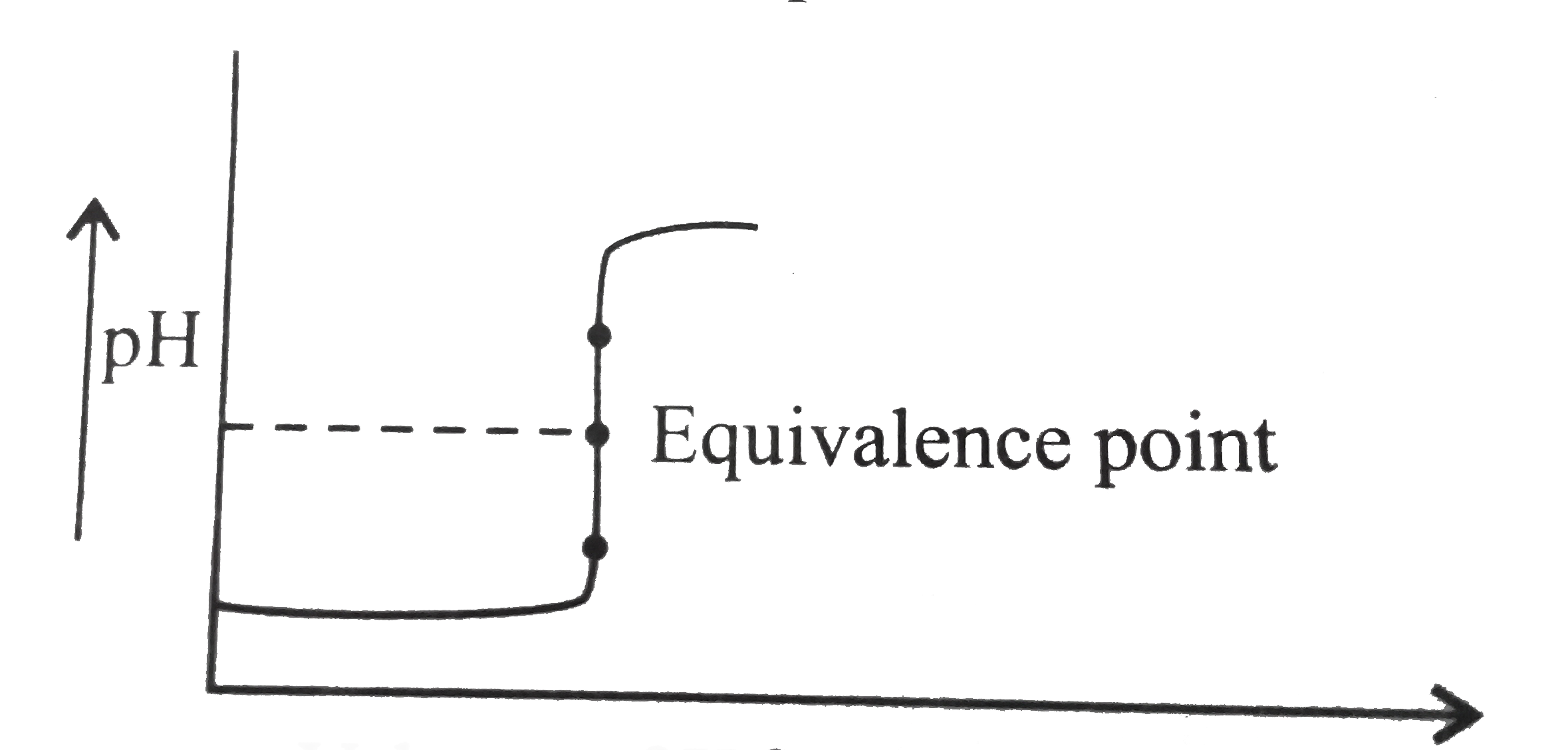
The suitable indicator for the titration is View SolutionQuestion 31
In acid-base titration react rapidly to neutralise each other. Equivalence point is a point at which the acid and the base (or oxidising agent and reducing agent) have beem added in equivalent quantities. The end point in the point at which the titration stops. since the purpose of the indicator is to stop the titration close to the point at which the acid and base were added in equivalent quantities, it is important that the equivalent point and the end point be as close as must change colour at a pH close to that of a solution of the salt of the acid base. Singificantly, the pH changes most rapidly near the equivalent point. The exact shape of a titration curve depends on Ka and Kb of acid and base.
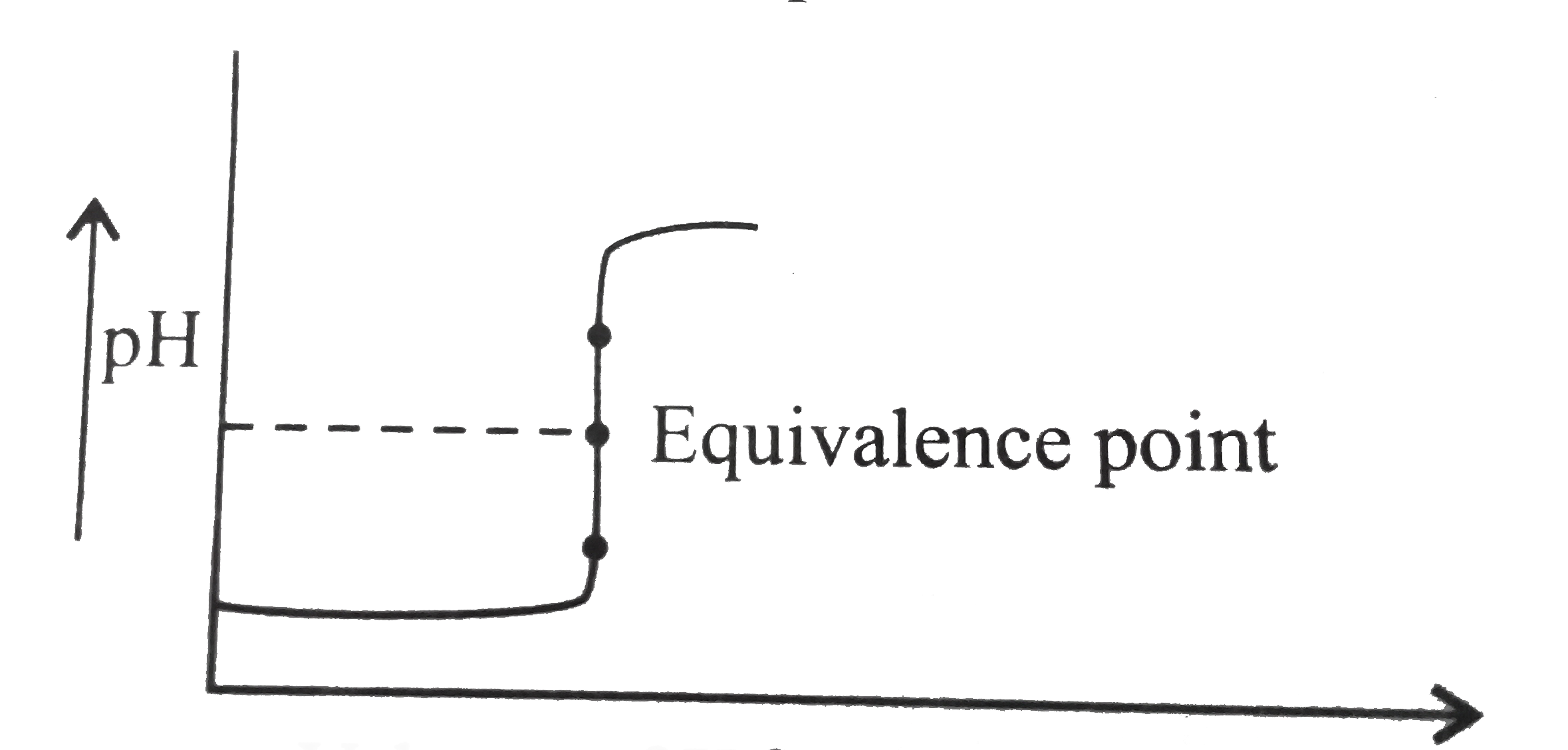
The pH at equivalence point is View SolutionQuestion 32
In acid-base titration react rapidly to neutralise each other. Equivalence point is a point at which the acid and the base (or oxidising agent and reducing agent) have beem added in equivalent quantities. The end point in the point at which the titration stops. since the purpose of the indicator is to stop the titration close to the point at which the acid and base were added in equivalent quantities, it is important that the equivalent point and the end point be as close as must change colour at a pH close to that of a solution of the salt of the acid base. Singificantly, the pH changes most rapidly near the equivalent point. The exact shape of a titration curve depends on Ka and Kb of acid and base.

Which of the following curves indicates the titration of a weak diprotic acid by KOH of equivalent strength? View SolutionQuestion 33
Physical and chemical equilibrium can respond to a change in their pressure, temperature, and concentration of reactants and products. To describe the change in the equilibrium we have a principle named Le Chatelier principle. According to this principle, even if we make some changes in equilibrium, then also the system even re-establishes the equilibrium by undoing the effect.
In the reaction N2(g)+3H2(g)⇔2NH3(g). If we increase the pressure of the system, the equilibrium isView SolutionQuestion 34
Physical and chemical equilibrium can respond to a change in their pressure, temperature, and concentration of reactants and products. To describe the change in the equilibrium we have a principle named Le Chatelier principle. According to this principle, even if we make some changes in equilibrium, then also the system even re-establishes the equilibrium by undoing the effect.
If we add SO2−4 ion to a saturated solution of Ag2SO4, it will result in a//anView SolutionQuestion 35
Physical and chemical equilibria can respond to a change in their pressure, temperature, and concentration of reactants and products. To describe the change in the equilibrium, we have a principle named Le Chatelier's principle. This we can define in terms of enegry, as the free energy change in equilibrium is zero means the system is stable. So if we are doing some changes in equilibrium, then the system having a tendency to reoestablish the equilibrium by undoing the effect we broughy. Consider the following equilibrium.
Three sparingly soluble salts A2B,AB, and AB3 are given. If all the three having the same value of solobility products (Ksp), in the saturated solution, the correct order of their solubilites is View SolutionQuestion 36
H3PO4 is a tribasic acid with pKa1,pKa2 and pKa31.12,7.21, and 12.32, respectively. It is used in fertiliser productions and its various salts are used in food, detrgent, toothpaste, and in metal treatment.
Small quantities of H3PO4 are used in inparting the sour or tart taste of soft drinkes, such as Coca Cola, and beers, in which H3PO4 is prese4nt 0.05% by weight (density =1.0gmL−1).
10−3MH3PO4(pH=7) is used in fertilisers as an aqueous soil digesting. Plants can absorb zinc in whater soluble from only. Zinc phosphate is the source of zinc and PO3−4) ions in the soil. Ksp of zinc phosphate =9.1×10−33.
Calculate the pH of a Coca Cola, assuming that the acidity of the cola arises only from H3PO4 and Ka2 and Ka3 are no importance. View SolutionQuestion 37
H3PO4 is a tribasic acid with pKa1,pKa2 and pKa31.12,7.21, and 12.32, respectively. It is used in fertiliser productions and its various salts are used in food, detrgent, toothpaste, and in metal treatment.
Small quantities of H3PO4 are used in inparting the sour or tart taste of soft drinkes, such as Coca Cola, and beers, in which H3PO4 is prese4nt 0.05% by weight (density =1.0gmL−1).
10−3MH3PO4(pH=7) is used in fertilisers as an aqueous soil digesting. Plants can absorb zinc in whater soluble from only. Zinc phosphate is the source of zinc and PO3−4) ions in the soil. Ksp of zinc phosphate =9.1×10−33.
[PO3−4] ion in the soil with pH=7, is View SolutionQuestion 38
H3PO4 is a tribasic acid with pKa1,pKa2 and pKa31.12,7.21, and 12.32, respectively. It is used in fertiliser productions and its various salts are used in food, detrgent, toothpaste, and in metal treatment.
Small quantities of H3PO4 are used in inparting the sour or tart taste of soft drinkes, such as Coca Cola, and beers, in which H3PO4 is prese4nt 0.05% by weight (density =1.0gmL−1).
10−3MH3PO4(pH=7) is used in fertilisers as an aqueous soil digesting. Plants can absorb zinc in whater soluble from only. Zinc phosphate is the source of zinc and PO3−4) ions in the soil. Ksp of zinc phosphate =9.1×10−33.
[Zn2+] ion in the soil is View SolutionQuestion 39
Aqueous solutions of Na2C2O4 and CaCI2 are mixed and precipitate of CaC2O4 formed is filered and dried. 250mL of the saturated solution of CaC2O4 required 6.0mL of 0.001MKMnO4 solution in acidic medium for complete titration.
Number of mol of KMnO4 required is this titration and number of mol of C2O2−4 ion present in the given saturated solution fo CaC2O4 respectively areView SolutionQuestion 40
Aqueous solutions of Na2C2O4 and CaCI2 are mixed and precipitate of CaC2O4 formed is filered and dried. 250mL of the saturated solution of CaC2O4 required 6.0mL of 0.001MKMnO4 solution in acidic medium for complete titration.
Equivalent of KMNO4 required in the titration and equivalent of C2O2−4 ion present in CaC2O4, respectively, are View SolutionQuestion 44
H∈ is an acidic indicator (KInd=10−7) which dissociates into aqueous acidic solution of 30mL of 0.05MH3PO4(K1=10−3,K2=10−7,K3=10−13)
If H∈ and IndΘ posses colour P and Q, respectively, and concentration of HIn is 120 times than that of IndΘ. colour Q predominates over P when concnetration of IndΘ is 127 times of HIn.
What is the pH range of the indicator. View Solution
All Exercises from CENGAGE CHEMISTRY Class 11 CHEMISTRY IONIC EQUILIBRIUM
- Archives Fill In The Blanks
- Archives Integer
- Archives Multiple Correct
- Archives Single Correct
- Archives Subjective
- Archives True/False
- Ex 8.1
- Ex 8.2
- Ex 8.3
- Ex 8.4
- Ex 8.5
- Exercises Assertion-Reasoning
- Exercises Integer
- Exercises Linked Comprehension
- Exercises Multiple Correct
- Exercises Single Correct
- Exercises Subjective (Buffer Solutions)
- Exercises Subjective (Hydrolysis Of Salt)
- Exercises Subjective (Polyprotic Acid)
- Exercises Subjective (Weak Acid And Weak Bases)
- Exercises Subjective(Coordination Equilibria)
- Exercises True/ False
- Solved Examples
